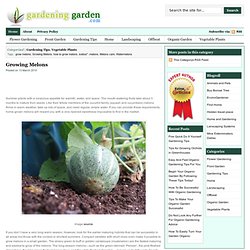

Erbs-medicins. Bonnie Plants - Garden Plants for Your Vegetable Garden or Herb Garden. Seeds. Potatos. Square Foot Gardening 101. Update!

Check out our new Square Foot Gardening Infographic for even more tips, diagrams, a plant list and much more. I recently stumbled upon a book (All New Square Foot Gardening: Grow More in Less Space! By Mel Bartholomew) with an interesting gardening method called square foot gardening, and decided we would give it a try. I’ve always thought the idea of having a vegetable garden would be a lot of fun. Planting times. Growing Melons. Summer plants with a voracious appetite for warmth, water, and space.

The mouth-watering fruits take about 3 months to mature from seeds. Like their fellow members of the cucurbit family (squash and cucumbers) melons thrive in warm weather, take up lots of space, and need regular, ample water. If you can provide these requirements, home-grown melons will reward you with a vine-ripened sweetness impossible to find in the market. Image source If you don’t have a very long warm season, however, look for the earlier maturing hybrids that can be successful in all areas but those with the coolest or shortest summers.
Watermelons—once considered long-season vegetables—can now he grown wherever cantaloupes mature reliably, thanks to new short-season varieties. Image source Melons respond dramatically to manure or fine compost in the soil and to being grown on mounds raised 6 inches above garden level for drainage and warmth. Image source Care. Harvesting. The Urban Farming Guys. PM819.pdf (application/pdf Object) 10 Plants That Repel Garden Insect Pests. 10 Plants That Repel Garden Insect Pests Please be sure to Join our email list and receive all our latest and best tutorials daily – free!

Background photo – Yummifruitbat (Wikipedia) lic. under CC 2.5 We’ve been doing some research into plants that repel pests and have compiled a list of 10 plants that can be planted together with other plants as a simple form of insect control. The idea of selecting plants for insect control is not a new one – and is part of the overall subject of companion planting. Companion planting has actually been in use since ancient times; for example the mosquito fern has been planted alongside rice in China for over 1000 years in order to assist with nitrogen fixing and the crowding out of other weeds.
As time passes by, it seems that more and more people are getting concerned (rightly!) Plant Guilds Booklet Midwest US Permaculture. We teach the fundamentals of plant guild design at every Permaculture Design Certificate (PDC) course we host.Here is our Upcoming Schedule From the Forward of the Plant Guild eBooklet As Midwest Permaculture grew, so did the number of requests from people looking for information and recommendations concerning what plants to add or combine to an existing tree on their landscape to create a useful plant guild.

We referred them to Midwest Permaculture’s “Official Plant Guy”, Bryce Ruddock, who chairs the discussions of Plant Guilds on our networking site. Eventually, we asked Bryce to design some foundational guilds as every day examples that would help guide those who are new to permaculture. After he completed these we asked a PDC student of ours, Jesse Tinges, to use his landscape architectural skills to create the sketches.
The team effort that emerged to create this booklet is actually a good example of how guilds, plant or human, really work together. Please use, experiment and enjoy! Popular Mechanics. Survival Gardening - Tough Times Ahead. And a Way to Relax and De-Stress Survival gardening can be fun, relaxing and actually quite simple… Many people seem to think they don’t have enough space for a garden but the areas where you can learn how to grow a basic vegetable garden are endless.

Yep, I am talking about those spaces we try to fill in with all kinds of flowers, shrubs, and even in some cases, gravel, so that it looks nice…. :) Plant your veggies there. Along Side Your House The area alongside the house is perfect for plants as it is protected from many things, such as: Frost, will stay frost-free longer in the fallcritters, we have to protect everything we grow here in Montana from hungry deerhail, heavy rains, strong wind… plus the plants seem to grow faster and I think it may be because heat is magnified. 9 Steps To Starting A Survival Garden. In a time of economic uncertainty and rising food prices, it it always a good idea to have a garden to provide extra food for you and your family.

Besides providing a source of food in an emergency, a garden is also a great source of wonderful vegetables which are MUCH healthier to eat than most of the food you can get at the supermarket. So how do you begin? The following are 9 steps that you can take to get your garden started..... #1) Decide What Your Goals Are - Do you want to grow enough just to add a few vegetables to your dinner once in a while? Do you want it to be able to provide enough food for your family if there is a major emergency? Some people who want to live "off the grid" end up building a garden large enough that it will provide almost all of the food that their family needs. . #2) Evaluate Your Land - Once you know what your goals are, you need to evaluate the land that you are currently living on.
So what is the solution? Comments comments. Survival Gardening. Survival gardening can provide fresh food for you and your family in the aftermath of a disaster.

Disasters can occur at anytime and anywhere, and take many forms. Not all disasters are dramatic and natural. Helping each other on the climb to self-reliance and preparedness…the Survival Sherpa way…One step at a time. Planting A Pineapple.